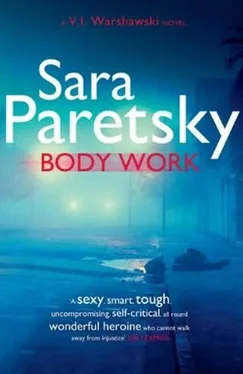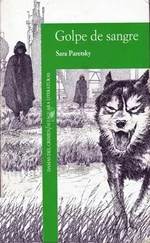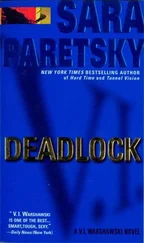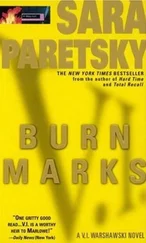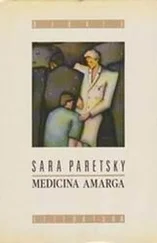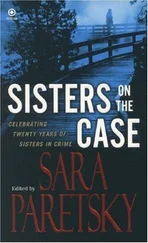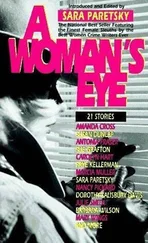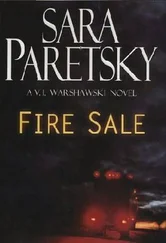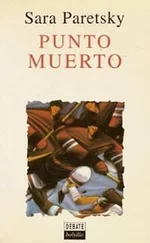The neighbor nodded, and started an involved story about his sister’s second son. I went into Nadia’s place and found a light switch. The neighbor, still talking, followed me in, but he fell silent when he saw the chaos created by yesterday’s “detectives.” Whoever had been searching, whatever they’d been looking for, they’d done a thorough job of tossing books from shelves and DVDs from their cases.
Like every artist I’ve known, Nadia covered her walls with pictures, masks, unusual found objects. Most of these had been flung to the floor, the hooks and the dust outlines on the walls showing where they’d once hung.
“Have you been in here before?” I asked the neighbor.
“I didn’t take anything,” he said. “You can’t accuse me of that.”
I looked at him closely. “So you have been in here. That was you in here yesterday, not people pretending to be detectives.”
“That isn’t true!” he cried. “They really came. I only wondered why. And they hadn’t locked the door when they left.”
“So you locked up behind them? How did you have a key to Ms. Guaman’s dead bolt?”
“She gave it to me. In case there was an emergency. Or to feed her cat when she was out of town.”
I had a hard time picturing the shy, intense Nadia with a life that took her out of town. Although maybe she’d gone around the country hunting for her dead sister’s lovers. People do odd things when they’re gripped by an obsession.
I walked through the apartment’s three rooms. In the bedroom, I found the one piece of art left on the walls: a crucifix, where the head of Jesus had been replaced by the head of a girl taken from an old doll. The hair had been pulled from the doll’s head and wrapped around the hands of the crucified Christ. The image was profoundly disturbing, not what I would want to wake to.
I realized there were no signs of a cat, no litter box, no food or water dishes. “Where is the cat?”
“In my home. When I learned Miss Nadia was dead, I took in the cat. She called it Ixcuina, after some old goddess. A strange name for an animal, but it is a strange animal.”
I looked from the dismantled apartment to his flushed face. I didn’t believe that he hadn’t been here yesterday, but I also didn’t think he would have destroyed the apartment if he’d been inside surreptitiously.
“So, Mr.-?”
“Urbanke,” he muttered, defensive.
“So, Mr. Urbanke, as a frequent visitor to Ms. Guaman’s, can you tell me what yesterday’s fake detectives might have taken with them? Can you tell if any of her art is missing?”
He looked around slowly but shook his head. “It-I can’t tell, with everything on the floor like this. Maybe if I put the pictures back on the wall…”
We spent the next hour or so matching artwork to dim outlines. We worked our way through the apartment’s three rooms, but at the end, even though there were still some gaps on the walls, Urbanke couldn’t tell what was gone.
“Besides,” he added, “she was always bringing in something new, taking down something she was tired of. It was like a museum, her private museum, where the exhibits were always changing. The one thing I don’t see is her computer. She kept it here.”
He pointed at a worktable in the corner of the apartment’s big front room. The table was built for artists or drafters; one half could be lifted up and down at different angles, depending on how the person liked to work, while the other half remained flat. The flat space, Nadia’s office worktop, held bills and a scattered pile of sketches. The charger for the computer was still plugged into the wall, but of the computer itself there was no trace.
Urbanke stood next to me looking through Nadia’s sketches. “Who knows if this artwork is valuable. Those detectives didn’t take it, but her computer, definitely you could sell it for drugs.”
We walked out together. I left Mr. Urbanke to lock Nadia’s door since he had a key, no matter how he’d gotten hold of it. I wanted to know what he’d taken besides the cat Ixcuina. I wondered, too, why Lazar and Cristina Guaman hadn’t come, but maybe collecting their daughter’s belongings was too much for them right now. In the entryway, I stopped to look at the mailboxes. Urbanke’s first name was Julian.
I bumped across the slush-packed roads to my office. My leasemate and I contribute to a service that shovels the walks on our street, along with the parking area that we share with the other two buildings abutting it. I thankfully abandoned my car in the small lot and went into my office to catch up with my messages.
Now I felt bewildered, almost split in half, by the two lives I was looking at. Did Chad Vishneski and Nadia Guaman have anything at all in common? Had her killer trashed her apartment? And if her killer wasn’t Chad, why was he being brought into her story at all?
All I could do was plod forward with what little I had to go on. The beer cans, pillowcase, and guns I’d collected from Mona Vishneski’s were still in my car, and I had Chad’s girlie magazines in my briefcase.
I had taken these things yesterday for no good reason except trying to put on a show for the client and his ex-wife-the ghost of Sherlock Holmes dictates that the detective sees something in the detritus of everyday life overlooked by ordinary mortals.
I packed up the guns and the empties and pillowcase and called a messenger to carry them to Cheviot labs. “There may be nothing here,” I wrote in my cover letter, “but please check to see whether anything besides beer was in these cans. And see if you can trace the purchase history on these guns.”
I didn’t include the magazines-I didn’t think I needed a comparative analysis of Arabic and British porn directed at U.S. servicemen. I put them into the Vishneski case file, to keep until the matter was resolved.
Once the messenger had left, I leaned back in my desk chair and studied my mother’s engraving of the Uffizi. Someone had gone through Nadia Guaman’s apartment. I didn’t trust her neighbor; he had Nadia’s keys, he’d helped himself to her cat. But he hadn’t needed to point out that her computer was missing. And he could have searched her place at his leisure, no need to turn it upside down. It was possible that she’d stiffed advances from him and that he’d murdered her himself and then trashed her apartment to finish off his fury-but even that meant Chad Vishneski wasn’t the killer.
The story was too complicated for me to follow without a chart. I drew one up on a big piece of newsprint and taped it to my wall. Rodney, the thug who had the run of Club Gouge, I needed his last name. I needed to know who he was, what hold he had on Olympia.
Then there were all the murky sleeping arrangements among the Body Artist, Nadia’s dead sister, Olympia, and the two women I’d met last night, Rivka and Vesta, whose last names I’d also need to get. Vesta, a black belt, had once been one of Karen Buckley’s lovers. When we’d spoken last night, she’d seemed calm, dispassionate even, in discussing the Body Artist. It was hard to believe she might have killed Nadia in a jealous frenzy.
Besides, according to the Artist, there’d been nothing in her relations with Nadia to make anyone jealous. I didn’t believe much of what Karen Buckley said, but her account of Nadia’s advances and retreats had a ring of truth to it.
The younger woman, Rivka, was a different story. She didn’t have much skin between her feelings and the world. Judging by last night’s behavior, she was jealous of everyone who captured the Artist’s attention. She could have believed there was more between Nadia and the Artist than ever really took place. And what about Alexandra? I needed more information about her, that was clear. If Nadia had known about the Artist’s private life, would the youngest sister, Clara, have known as well? Or would the two older girls have protected the baby of the family? I toyed with a fantasy in which the Guamans murdered their daughter so that her sexuality would remain a deeply buried secret.
Читать дальше
